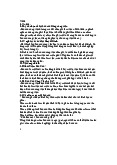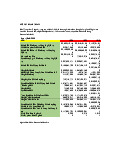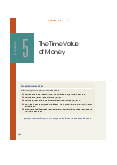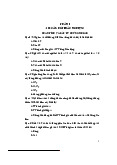






Preview text:
1.
Textile Mills borrows money at a rate of 13.5 percent. This interest rate is referred to as the: A. compound rate. B. current yield. C.costofdebt. D. capital gains yield. E. cost of capital. 2.
7. Which one of the following is the primary determinant of a firm's cost of capital? A. debt-equity ratio B. applicable tax rate C. cost of equity D. cost of debt
E.useofthefunds 3.
The cost of preferred stock is computed the same as the: A. pre-tax cost of debt. B. return on an annuity. C. aftertax cost of debt.
D.returnonaperpetuity.
E. cost of an irregular growth common stock. 4. The cost of preferred stock:
A.isequaltothedividendyield.
B. is equal to the yield to maturity.
C. is highly dependent on the dividend growth rate.
D. is independent of the stock's price.
E. decreases when tax rates increase. 5.
A $25 investment produces $27.50 at the end of the year with no risk. Which of the following is not true?
A. NPV is positive if the interest rate is less than 10%.
B.NPVisnegativeiftheinterestrateislessthan10%.
C. NPV is zero if the interest rate is equal to 10%. 6.
The difference between the present value of an investment's future cash flows and its initial cost is the:
A.netpresentvalue. B. internal rate of return. C. pay back period. D. discounted pay back period.
7. An investment with an initial cost of $16,000 produces cash flows of $5000
annually. If the cash flow is evenly spread out over the year and the firm can
borrow at 10%, the discounted payback period is _____ years. (4.05)
8. The discounted payback period rule:
A. considers the time value of money.
B. discounts the cutoff point.
C. ignores uncertain cash flows.
D. is preferred to the NPV rule.
9. It will cost $5,000 to acquire a small ice cream cart. Cart sales are expected to be
$2,000 a year for three years. After the three years, the cart is expected to be
worthless as that is the expected remaining life of the cooling system. What is the
payback period of the ice cream cart? A. 2.00 years. B. 3.00 years. C. 2.7 years. D. 2.5 years.
10. A project has an initial cost of $9,700 and produces cash inflows of $4,100,
$5,200, and $1,300 over the next three years, respectively. What is the
discounted payback period if the required rate of return is 9%? A. 2.31 years B. 3.00 years C. 2.5 years D. never
11. The profitability index is the ratio of:
A. average net income to average investment.
B. internal rate of return to current market interest rate.
C. net present value of cash flows to internal rate of return.
D. net present value of cash flows to average accounting return.
E. present value of cash flows to initial investment cost.
12. If there is a conflict between mutually exclusive projects due to the IRR, one should:
A. drop the two projects immediately.
B. spend more money on gathering information.
C. depend on the NPV as it will always provide the most value.
D. depend on the AAR because it does not suffer from these same problems BT 1.
Chelsea Fashions is expected to pay an annual dividend of $0.80 a share next year. The market
price of the stock is $22.40 and the growth rate is 5 percent. What is the firm's cost of equity? A. 7.58 percent B. 7.91 percent C. 8.24 percent D.8.57percent E. 9.00 percent 2.
The Shoe Outlet has paid annual dividends of $0.65, $0.70, $0.72, and $0.75 per share over the
last four years, respectively. The stock is currently selling for $26 a share. What is this firm's cost of equity? A. 7.56 percent B.7.93percent C. 10.38 percent D. 10.53 percent E. 11.79 percent 3.
Sweet Treats common stock is currently priced at $19.06 a share. The company just paid $1.15
per share as its annual dividend. The dividends have been increasing by 2.5 percent annually and
are expected to continue doing the same. What is this firm's cost of equity? A. 6.03 percent B. 6.18 percent C. 8.47 percent D.8.68percent E. 8.82 percent 4.
The outstanding bonds of Tech Express are priced at $989 and mature in 8 years. These bonds
have a 6 percent coupon and pay interest annually. The firm's tax rate is 39 percent. What is the firm's aftertax cost of debt? A. 3.01 percent B. 3.22 percent C. 3.35 percent D.3.77percent E. 4.41 percent 5.
Simple Foods has a zero coupon bond issue outstanding that matures in 9 years. The bonds are
selling at 42 percent of par value. What is the company's aftertax cost of debt if the tax rate is 38 percent? A. 5.48 percent B. 5.73 percent C.6.12percent D. 7.73 percent E. 9.88 percent 6.
Grill Works and More has 8 percent preferred stock outstanding that is currently selling for $49
a share. The market rate of return is 14 percent and the firm's tax rate is 37 percent. What is the
firm's cost of preferred stock? A. 14.77 percent B. 15.29 percent C. 15.67 percent D.16.33percent E. 16.54 percent 7.
Samuelson Plastics has 7.5 percent preferred stock outstanding. Currently, this stock has a
market value per share of $52 and a book value per share of $38. What is the cost of preferred stock? A. 7.50 percent B. 13.88 percent C.14.42percent D. 19.29 percent E. 19.74 percent 8.
Nelson's Landscaping has 1,200 bonds outstanding that are selling for $990 each. The company
also has 2,500 shares of preferred stock at a market price of $28 a share. The common stock is
priced at $37 a share and there are 28,000 shares outstanding. What is the weight of the
common stock as it relates to the firm's weighted average cost of capital? A. 43.08 percent B.45.16percent C. 47.11 percent D. 54.00 percent E. 55.45 percent
9. Mangrove Fruit Farms has a $200,000 bond issue outstanding that is selling at 92 percent of face
value. The firm also has 1,500 shares of preferred stock and 15,000 shares of common stock
outstanding. The preferred stock has a market price of $35 a share compared to a price of $24 a
share for the common stock. What is the weight of the preferred stock as it relates to the firm's
weighted average cost of capital? A. 6.75 percent B. 7.20 percent C. 7.75 percent D. 8.30 percent E.8.80percent
10. Electronics Galore has 950,000 shares of common stock outstanding at a market price of $38 a
share. The company also has 40,000 bonds outstanding that are quoted at 106 percent of face
value. What weight should be given to the debt when the firm computes its weighted average cost of capital? A. 42 percent B. 46 percent C. 50 percent D.54percent E. 58 percent
11. Wayco Industrial Supply has a pre-tax cost of debt of 7.6 percent, a cost of equity of 14.3
percent, and a cost of preferred stock of 8.5 percent. The firm has 220,000 shares of common
stock outstanding at a market price of $27 a share. There are 25,000 shares of preferred stock
outstanding at a market price of $41 a share. The bond issue has a face value of $550,000 and a
market quote of 101.2. The company's tax rate is 37 percent. What is the firm's weighted average cost of capital?
12. Central Systems, Inc. desires a weighted average cost of capital of 8 percent. The firm has an
aftertax cost of debt of 4.8 percent and a cost of equity of 15.2 percent. What debt-equity ratio
is needed for the firm to achieve its targeted weighted average cost of capital?
13. Kelso's has a debt-equity ratio of 0.55 and a tax rate of 35 percent. The firm does not issue
preferred stock. The cost of equity is 14.5 percent and the aftertax cost of debt is 4.8 percent.
What is the weighted average cost of capital?
14. Consider an investment with an initial cost of $20,000 and is expected to last for
5 years. The expected cash flow in years 1 and 2 are $5000, in years 3 and 4 are
$5,500 and in year 5 is $1,000. The total cash inflow is expected to be $22,000
or an average of $4,400 per year. Compute the payback period in years. 3.82
15. An investment project has the cashflow stream of -250, 75, 125, 100, and 50.
The cost of capital is 12%. What is the discount payback period? (3.38 years)
16. Ginny is considering an investment which will cost her $120,000. The investment
produces no cash flows for the first year. In the second year the cash inflow is
$35,000. This inflow will increase to $55,000 and then $75,000 for the following
two years before ceasing permanently. Ginny requires a 10% rate of return and
has a required discounted payback period of three years. Ginny should _______
this project because the discounted payback period is ______ . A. accept; 2.03 years B. accept; 2.97 years C. accept; 3.97 years D. reject; 3.03 years E. reject; 3.97 years (Image)
22. An investment that requires initial cash outlay of $100,000 has a useful life of 3
years. In each of these years the before-tax cash flow is $40,000. If the tax rate is 34%
and straight-line depreciation is used, the average accounting return is: A. 40.00%. B. 26.40%. C. 13.34%. D. 8.80%. (Image)
26. A mutually exclusive project is a project whose:
A. acceptance or rejection has no effect on other projects. B. NPV is always negative. C. IRR is always negative.
D. acceptance or rejection effects other projects.
29. The internal rate of return may be defined as:
A. the discount rate that makes the NPV cash flows equal to zero.
B. the difference between the market rate of interest and the NPV.
C. the market rate of interest less the risk-free rate.
D. the project acceptance rate set by management. (Image)
30. The Balistan Rug Company is considering investing in a new loom that will cost $12,000.
The new loom will create positive end of year cash flow of $5,000 for the next 3 years. The
internal rate of return for this project is: A. between 10% and 15%. B. between 15% and 20%. C. between 20% and 25%. D. between 25% and 30%. E. less than 10%. (Image)
44. Suppose that a project has a cash flow pattern (-$2,000, $25,000, -$25000) Its IRR is given by: A. 12.20% B. 9.61% or 1040.39% C. 25.25% or 250.52% D. 4100.11% (Image)
48. The Ziggy Trim and Cut Company can purchase equipment on sale for $4,300. The
asset has a three-year life, will produce a cash flow of $1,200 in the first and second
year, and $3,000 in the third year. The interest rate is 12%. Calculate the project's
payback assuming end of year cash flows. Also, calculate project's IRR. Should the
project be taken? Check your answer by computing the project's NPV. Payback-2.633 Years.
Trial and error produces IRR = 10.41%. Do not take project as IRR < 12% Reject the project NPV = ($136.60) (Image)
50. The Walker Landscaping Company can purchase a piece of equipment for $3,600.
The asset has a two-year life, will produce a cashflow of $600 in the first year and
$4200 in the second year. The interest rate is 15%. Calculate the project's payback
assuming steady cashflows. Also calculate the project's IRR. Should the project be
taken? Check your answer by computing the project's NPV. Payback = 1.714 years
Calculated IRR = 16.67. Accept the project. NPV = $97.54. (Image)
53. Given the cash flow stream of the following mutually exclusive projects, prove
through the incremental investment that Project B, with the higher NPV, will be preferred to project A. 0 1 2 3 NPV IRR
Project A: -500 150 245 320 46.39 17.76
Project B: -800 360 360 360 50.01 16.65
Incremental investment in B: -300 210 115 40 NPV = 3.63




